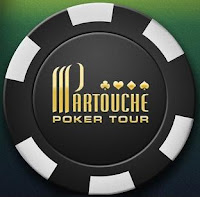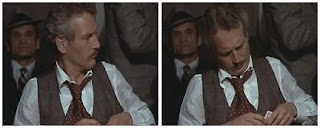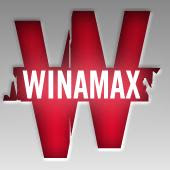Travel Report: WPT Marrakech, Day 2
 Managed to secure nearly five hours of sleep prior to yesterday’s Day 2 of the Main Event of the World Poker Tour Marrakesh presented by Chilipoker. More than twice what I’d had each of the previous two nights, and so it felt positively luxurious to roll out of bed around 11 a.m. Sure, I missed breakfast -- and, most crucially, coffee -- in order to get the extra winks. But it was necessary.
Managed to secure nearly five hours of sleep prior to yesterday’s Day 2 of the Main Event of the World Poker Tour Marrakesh presented by Chilipoker. More than twice what I’d had each of the previous two nights, and so it felt positively luxurious to roll out of bed around 11 a.m. Sure, I missed breakfast -- and, most crucially, coffee -- in order to get the extra winks. But it was necessary.Had to get over to the Casino de Marrakech an hour earlier yesterday, and so shortly after noon Mickey, Elissa, and I set out on foot to our destination, the wind whipping alarmingly hard as we went. Got there in good shape, though, and soon we were settled in for another day of reporting.
As the field shrunk, Mickey increasingly took on field reporter duties, keeping track of bustouts, seat changes, and chip counts (all of which Mickey does so well) while Elissa and I mostly stuck to blogging. That meant getting to sit a little more than the previous two days, when all three of us were on our feet constantly. I was glad for the change, especially given all the walking I had done yesterday morning prior to the long day at the tourney.
Matthew Parvis of PokerNews -- stopping through on his travels to and from the many other events happening these days -- spent some of the day with us yesterday, and so it was good to touch base with him. I also got to meet Tatjana Pasalic, a.k.a. “Tattytats,” who seemed friendly and funny. (You might remember Tatjana from her interview of Kevmath a couple of months back.) And Jesse May (author of the great poker novel, Shut Up and Deal) stopped by as well, and I enjoyed talking with him once again about his travels, his podcast, and poker writing, generally speaking.
They ended up only playing ten one-hour levels yesterday (we’d originally heard it would be 12), which meant we were able to get back to the hotel around 2 a.m. rather than 4-4:30 a.m. as had been the case previously. Began with 82 players and just nine made it to today’s final day of play.
Wasn’t an overly remarkable day, poker-wise, but a few stories have emerged over the course of the tourney. None of the “name” pros made it to the final 27 and the cash. A couple of local players did. Roger Hairabedian -- known as “Big Roger” (because he is quite large) -- finished 23rd. And Majid Chiboub finished 20th, a boisterous, good-natured fellow whom absolutely everyone at the casino knew (just as “Majid”).
A famous French rap star played in the event, a fellow named Bruno Lopes who goes by “Kool Shen.” He fronts the group NTM, which if you look it up online you’ll discover stands for something not too nice about your mother. Lopes is about my age, actually. His age, coupled with the fact that he appeared very steady and unemotional throughout the tourney, made it seem funny to imagine him onstage delivering an aggressive rap as I am imagining from the group’s name he must do. Will have to check out some NTM, I think, after I return. Lopes finished 15th.
The other interesting story yesterday concerned a young German player named Dominik Nitsche whom reporters have gotten to know quickly from some of the other tours outside the States. Guy is only like 19 or 20 I believe. Yesterday Nitsche was down under 5,000 chips with about 60 players left. Then he doubled up three times, but even then still had something less than a third an average stack. He doubled up a couple more times, though, then won a few more big pots, and by the early evening was the chip leader. He’ll be second in chips to start today’s final table.
I remember one big hand in there during his run -- right before dinner break, I think -- in which Nitsche knocked out yet another player, this time with pocket queens against his opponent’s A-Q. I was writing up the hand afterwards and realized I wasn’t quite sure how much his opponent had had to start the hand, so I asked him. He grinned and said at first “I don’t even know!” before coming up with a close estimate. It was kind of fun to see him excited like that about how things had been going for him over the previous couple of hours.
 Really the mood in the poker room has been upbeat all week, with everyone -- players, staff, media -- seeming to enjoy themselves. I remember a similarly fun vibe at EPT Kyiv last summer. Sometimes the mood at WSOP events will also be light, but more often than not things are much more serious and tense, perhaps because of all the added stress and pressure (for everyone) surrounding the Series.
Really the mood in the poker room has been upbeat all week, with everyone -- players, staff, media -- seeming to enjoy themselves. I remember a similarly fun vibe at EPT Kyiv last summer. Sometimes the mood at WSOP events will also be light, but more often than not things are much more serious and tense, perhaps because of all the added stress and pressure (for everyone) surrounding the Series.Today’s final table will be happening in a different location in the casino, so I’m not quite sure what the arrangement will be. I’m confident, though, that all will be well for those of us reporting on it, as we’ve been taken care of pretty well throughout. Between Matt Savage (who is the TD here for this one), the Chilipoker folks, and the Casino de Marrakech people, the whole event has been very well managed, in my opinion.
Spaceman commented yesterday about the big cash games going on in Marrakech, and indeed I have seen those running every day thus far, with David Benyamine always there in his seat at the end of the main table. It isn’t really feasible to go up and watch, and so I can’t offer further details of what is happening there. But I can confirm the games are ongoing, and there’s a lot of murmuring here and there regarding the high stakes and the fact that the games keep going around the clock.
Think I’ll go ahead and pack now and get ready to head back over. As I mentioned yesterday, we might be cutting things close as far as our flight out of here goes, as we are due to depart before dawn tomorrow. Hopefully the tourney finishes up at least a few hours before then, so we can make it okay. Also, we’re hearing there’s snow in Paris (where we have a connection), so who knows what sort of twists and turns await us as we try to make our way back homeward.
Head over to PokerNews today to see how this sucker plays out. And come back here to see how the trip home is going. Not sure if I’ll even be able to post tomorrow, given the schedule, but if I can get onlinle I’ll at least be on Twitter @hardboiledpoker with updates.
Labels: *high society, WPT Marrakech






 . I actually saw him fold A-Q face up one other time during that sequence when he appeared short enough to jam any ace or pair.
. I actually saw him fold A-Q face up one other time during that sequence when he appeared short enough to jam any ace or pair. 


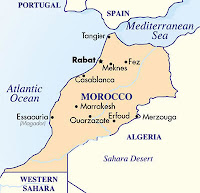





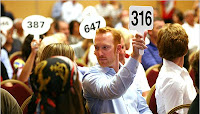







 . Nice starter, that. A hand I would likely raise with if opening late. But here I was out of position and had no feel as yet for how my opponents played, so I just completed for the quarter. Often I’ll start sessions conservatively -- for better or worse -- although in truth I very rarely play hands from the small blind, even if I’m in a more aggressive mode.
. Nice starter, that. A hand I would likely raise with if opening late. But here I was out of position and had no feel as yet for how my opponents played, so I just completed for the quarter. Often I’ll start sessions conservatively -- for better or worse -- although in truth I very rarely play hands from the small blind, even if I’m in a more aggressive mode. 

 . Top pair, open-ender, second-nut flush draw. I liked it. I made note of what the button had left -- only about $4 -- and figuring he’d hit something decided I’d try to play for his stack when he made his continuation bet. The BB checked as well, and the button cooperated by betting 50 cents. I reraised the pot, the BB folded, and my remaining opponent just called, leaving himself a paltry $1.31.
. Top pair, open-ender, second-nut flush draw. I liked it. I made note of what the button had left -- only about $4 -- and figuring he’d hit something decided I’d try to play for his stack when he made his continuation bet. The BB checked as well, and the button cooperated by betting 50 cents. I reraised the pot, the BB folded, and my remaining opponent just called, leaving himself a paltry $1.31.  . Easy game. Now holding the ultimate hand, I checked, hopeful my opponent wouldn’t decide to preserve his remaining pennies. After a few seconds he put his chips in, I called, and that was that. (He had K-Q-J-2 for two pair.) A small pot -- just $8.40 total -- though usually it’s hard to get paid anything at all with such a big hand, so I’ll take it.
. Easy game. Now holding the ultimate hand, I checked, hopeful my opponent wouldn’t decide to preserve his remaining pennies. After a few seconds he put his chips in, I called, and that was that. (He had K-Q-J-2 for two pair.) A small pot -- just $8.40 total -- though usually it’s hard to get paid anything at all with such a big hand, so I’ll take it.


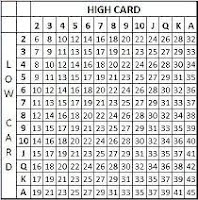

 while the BB turned over
while the BB turned over 
